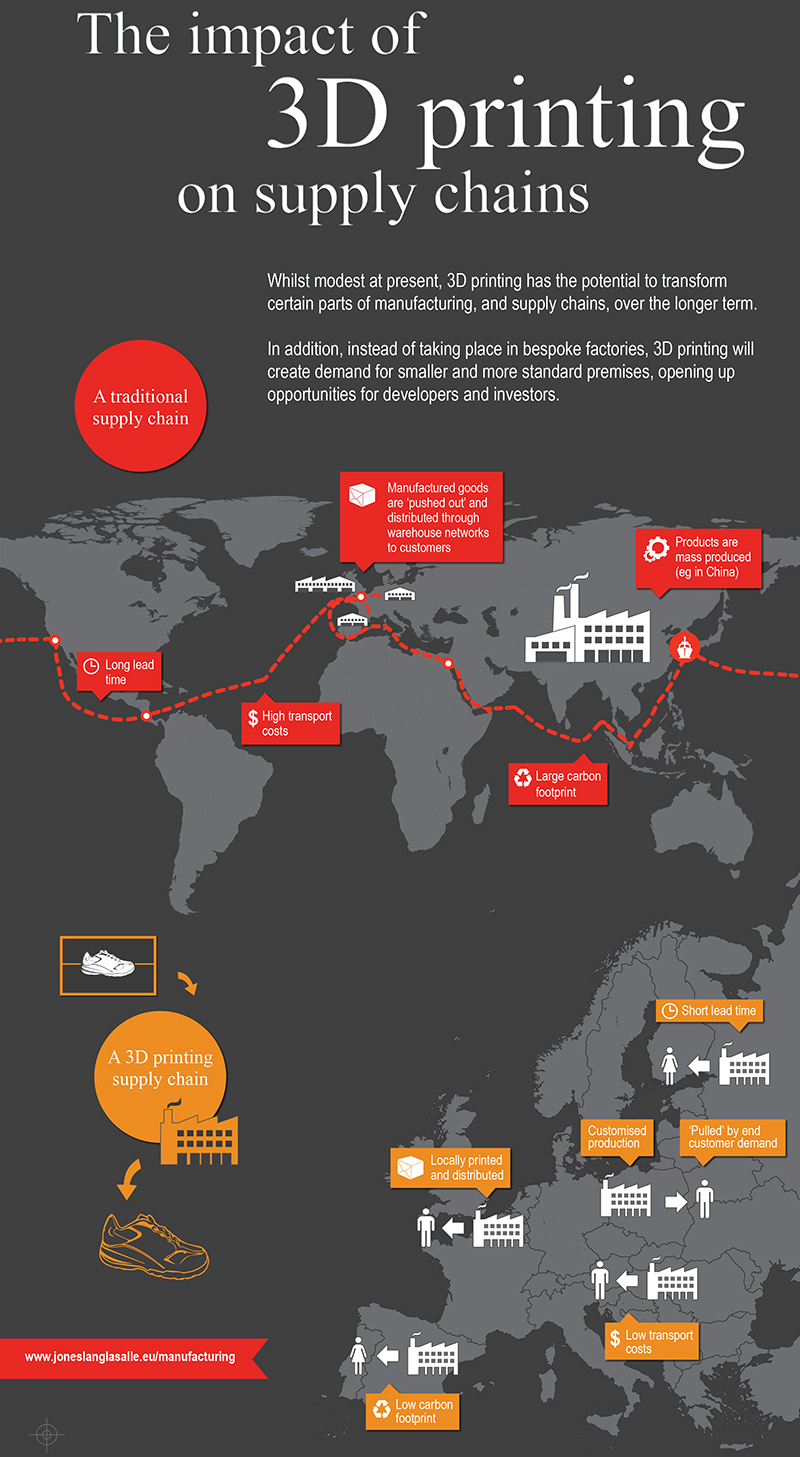Supply Chains and Third-Party Logistics Make Room for 3D Printing
So how will 3D Printing impact the supply chain and logistics? It will accelerate a shift from “push supply chains” to “pull supply chains.”
Although it represents the fifth largest concentration of supply chain companies in the nation, Metro Atlanta does not plan to rest on its laurels.
Helping grow an efficient and consistent logistics and supply chain network is the primary goal of the Metro Atlanta Chamber of Commerce and its Supply Chain Leadership Council (SCLC).
With more than 90 members that include logistics giants such as Delta Air Lines, Manhattan Associates, Norfolk Southern and others, SCLC meets quarterly to discuss trends affecting the industry. Recently, the group joined the Georgia Tech Manufacturing Institute to learn how 3D printing, or additive manufacturing, will impact the supply chain.
With the “instant manufacturing” possibilities offered by 3D printing, everyone is considering getting on the bandwagon. “McDonald’s may soon be printing the toys in Happy Meals because kids aren’t happy with the toys they are getting,” explained Dr. Chip White, Schneider National Chair of Transportation and Logistics, Georgia Tech School of Industrial Systems and Engineering. “And a 3D printer has been put in a library in the Baltimore area to allow people to come in and print anything they want. So there is a lot of interest in this manufacturing process.”
But 3D printing is a completely different form of manufacturing, which can drastically impact the supply chain system.
Additive manufacturing processes currently include extrusion, granular, laminated and light polymerized. These processes use materials such as thermoplastics and thermoplastics powders, metal alloys, paper, liquid resins and more. Typically, 3D printing is used for rapid prototyping and manufacturing for automotive, aerospace and medical industries to produce parts, jigs, tools, etc., as well as for manufacturing mass customization products such as art, jewelry, and toys. Because it is more of an “on demand” process, the raw materials, or feedstock, need to be close at hand.
So how will this impact the supply chain and logistics? It will accelerate a shift from “push supply chains” to “pull supply chains.” With 3D printing, the long production runs for mass production will often give way to limited production runs for customer-driven mass customization and build-to-order products. 3D printing is not yet conducive to mass production due its typically higher cost per unit and slower production time per unit.
However, with 3D printing, manufacturing will become more agile and better able to react to customer demands. This means there will be less work-in-progress and finished product in transport and in stock and less obsolescence of existing stock. Although the cost per unit may be higher, with reduced storage and less outdated product, the overall supply chain system costs may be lower than that of traditional manufacturing supply chains.
“Products can be made closer to the consumer,” said Dr. White. “3D printing supports a build-to-order, mass customization environment, and in some cases it will allow for product differentiation to be postponed in the supply chain process. There will be a dramatic increase in information transmission. The feedstock, often very versatile and useful for several products, becomes the inventory. This process is ideal for small batches and uncertain demand.”
Instead of manufacturers producing products based on forecasted demands, 3D printing allows for manufacturing based on real-time demand. This results in shorter lead times from order to delivery. “The supply chain will be much more flexible in order to accommodate surges in product demand,” said Dr. White. “This is applicable in many areas, but it certainly has military implications.”
Dr. Ben Wang, Chief Manufacturing Officer for Georgia Tech, said that this trend provides a lot of opportunity for the Southeast. As Dr. White pointed out, 3D printing already is used by industries such as aerospace and automotive. These industries have a large manufacturing presence in the Southeast United States. In fact, Dr. Wang presented a map of the U.S. Southeast with 31 original equipment manufacturers in the automotive, aerospace and power generation sectors – all potential users of 3D printing technology. “These industries have a large presence in the Southeast already,” Dr. Wang explained. “Each of these industries has a supply chain, so we have a great opportunity to collaborate and face the challenges for these supply chains.”
Video: 3D Printing - Opportunity or Threat for 3PLs?
eft’s recent European flagship logistics and supply chain event, the 3PL Summit and Chief Supply Chain Officer Forum, explored the industry game changers, opportunities and technologies facing senior executives from 3PL providers and their customers. The top level speaker faculty shared their exclusive inside knowledge and top takeaways on a number of the key issues affecting the industry.
Recent innovations in technology have dominated supply chain discussions, with 3D printing taking centre stage. Some recent findings from eft research highlighted that nearly 20% of those transport, logistics and supply chain executives surveyed were currently using 3D printing to some degree. Just under 40% believed 3D printing would have the most impact on increased customization.
The 3D printing session at the 3PL Summit attracted a lot of interested parties as Martin Wegner, VP Solutions and Innovation at DHL Innovation kicked off the conversation debating how 3D printing might impact both manufacturing and consumer behavior. Sebastiaan Scholte, CEO at Jan De Rijk joined Martin later to express his views on how implementation of 3D printing may affect the air cargo business.
The eft team caught up with Sebastiaan Scholte after his presentation to further explore his perspective on 3D printing in this short video interview.
According to Sebastiaan, who has more than 16 years in the air cargo and logistics industry , 3D printing is “going to change and revolutionize traditional manufacturing but I think it’s going to enhance it instead of replacing it…”
He believes that there is still a long way to go in terms of the speed of 3D printing but “it will help develop prototypes faster….and you will improve production”.
Sebaastian predicts: “It’s an interesting development but it’s not going to change a lot in the industry”.
For the latest logistics and supply chain trends check out the Hi-Tech & Electronics Supply Chain Summit on May 21-22nd in Amsterdam and the 3PL Summit & Chief Supply Chain Officer Forum on June 11-13th in Chicago.
Related: The Implications of 3D Printing For The Global Logistics Industry
View All SC24/7 Content on “3D Printing”













